David's Astronomy Pages
Notes - Session 611.2 (2018-05-22,
Observatory Commissioning)
Notes
(S611)
Notes
Main
Home
Page
Notes
(S612)
David's Astronomy Pages
|
Notes (S611) |
Notes Main |
Home Page |
Notes (S612) |
| Session Aims & Highlights | |
| Operational Issues | |
| - Critical Issues (0), Major Issues (1), Minor Issues (3), Small Defects (0), Continuous Improvement (0) | |
| Aligning GuideScope | |
| Mapping Horizon | |
| Clear View Checks | |
| Observatory Manager Testing | |
|
|
No images from this session >> |
Main Aims
This was a daytime session was to continue formal commissioning of the new Dome Observatory including :
Equipment & Software
Highlights
Notes
Summary Plots & Logs
Back to Top
Back to Top
Guidescope focused on terrestrial objects (little change required), and then
aligned with LX200 Main Scope. The latter was perform by continuously acquiring
and visually comparing images of a distant lamp-post through both scopes (whilst
tracking was set to Off otherwise the lamp-post would move out of view) and then use
'Orion XY Guidestar Finder' between Scope and Camera to align
the center of the Guidescope's view with the center of the Main Scope's view
- 12" LX200
Main Scope + ST-10XME with CCDSoft5
(0.11s exposures with H alpha filter)
- 80mm APO GuideScope + ZWO ASI 178MC with
SharpCap3 (2ms exposures)
|
Aligning Guidescope Comparing MainScope view in CCDSoft5 (left) with Guidescope View in SharpCap (right) |
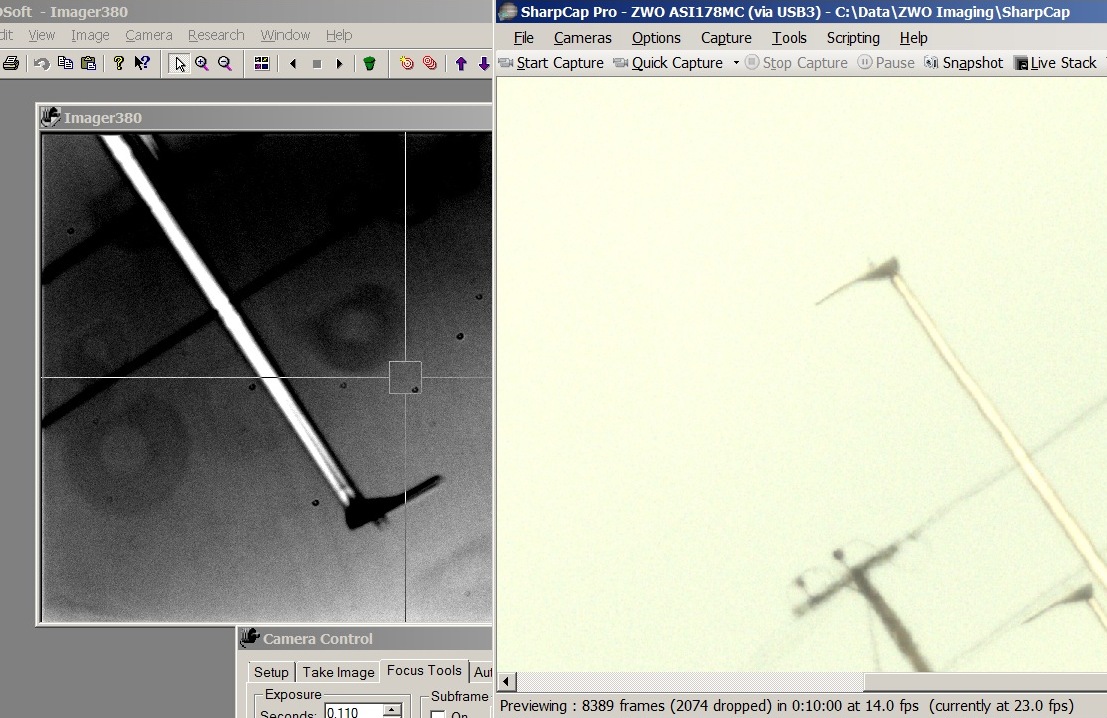 |
| Using 'Orion XY GuideStar Finder' to bring Guidescope into perfect alignment with LX200 Main Scope |
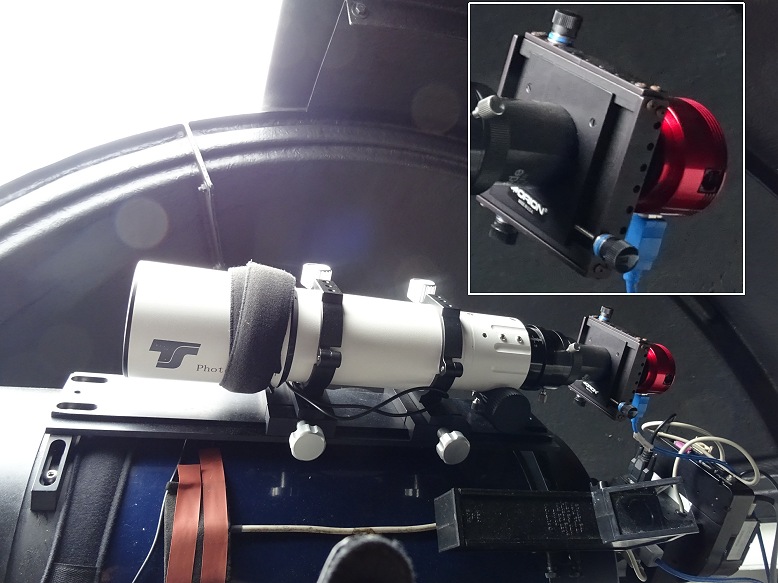 |
Back to Top
Local Horizon was mapped and uploaded to TheSky6 as a Local Horizon reference
line. This was done as follows:
a) Autostar II handbox used to move scope
along horizon whilst viewing images continuously acquired using 80mm Guidescope
+ ASI 178MC camera with SharpCap3 (This was done in a zig/zag manner due to
RA/Dec motions). Altitude of Horizon recorded at roughly every 1 deg of Azimuth
and entered in a spreadsheet.
b) Horizon data (360 altitude values from
Azim 0 to Azim 359 deg) copied from spreadsheet, pasted into TheSky's Horizon
Editor and then saved as the site's new Local Horizon reference file).
| Mapping Horizon using GuideScope + ZWO ASI 178MC Camera |
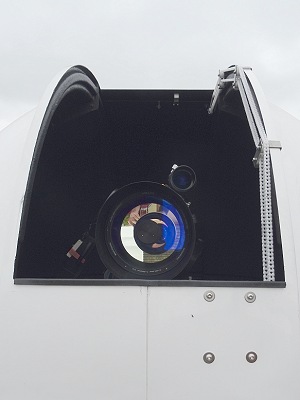 |
|
Mapped Horizon in TheSky6's Horizon Editor (Horizon Altitude varies between 0.5 and 14 deg) |
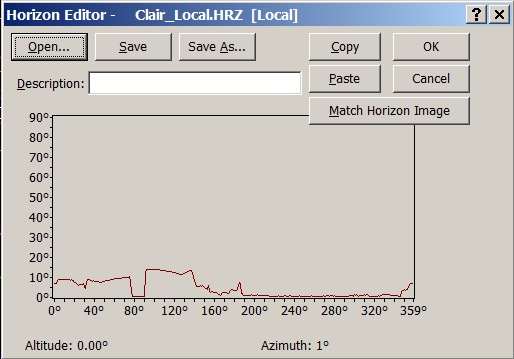 |
Whilst not necessarily with a 100% clear view, it was noted that horizon was also visible using LX200 down to altitudes as low as 0.5 deg. This had not been anticipated as planning had worked on basis that LX200 would be able to see down to altitude of 5 deg with 100% clear view, but carried no expectation of it being able to see much lower than this. Checking the Observatory/Telescope Spreadsheet Model shows that observations down to 0.5 deg altitude are potentially feasible, though high airmass will probably prevent any really useful observations or imaging.
|
Observatory with Main Scope pointing South with Altitude 0.5
deg (estimated 70% clear view + 30% occlusion by lower roof ) |
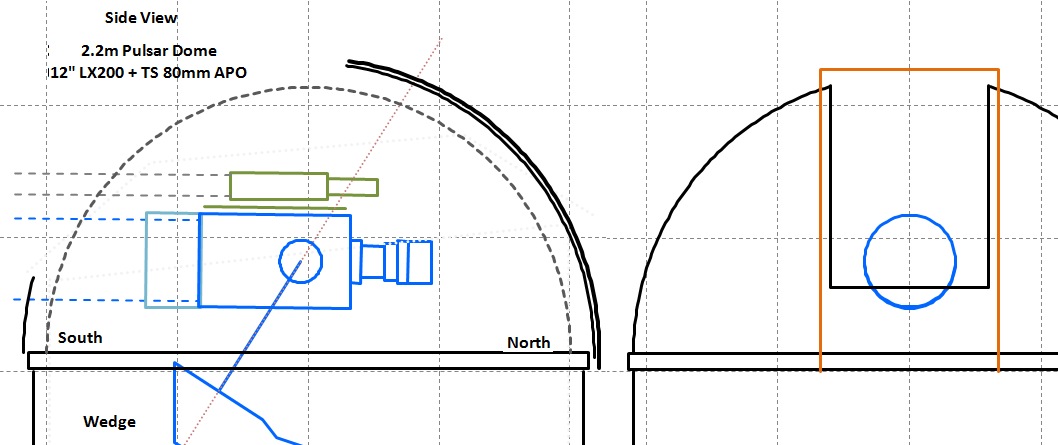 |
Back to Top
An examination of potential clear view limits for the Main Scope and GuideScope was performed in daylight with the Shutter Open and with the Dome Slaved to Telescope Position using POTH.Hub. Particular checks were made around Zenith where it was expected that GuideScope would stop having a clear view of the sky at certain altitudes above ~80 deg.
- First series of checks with scope at altitudes between 5 and 30 degrees successfully demonstrated that the Main Scope had clear view visibility of the sky at all Azimuth positions. These were accompanied by checks that successfully demonstrated that the Guide Scope also maintained clear view visibility of the sky at all Azimuth Positions, including due E and due W where the GuideScope lies at angles that tip it towards the edge of the shutter aperture. (This had already been previously examined and checked during the observatory planning stage using Observatory/Telescope spreadsheet charting, but it was satisfying to demonstrate this in the actual Observatory)
- Second series of checks examined viewing around Zenith. As
expected the GuideScope loses clear view visibility of the sky when pointing due
south from around altitude 79-80 deg and above. This only applies when pointing
south or close to south. When pointing towards east or west the GuideScope
maintains clear view visibility above 80 deg. However when pointing east at
targets with Declination lower than 57 deg (my latitude) the dome will begin to
rotate around to the south as the target tracks across the sky, causing the
guidescope to be gradually occluded by the observatory in the process.
When the star lies north of zenith the Guidescope tends to maintain clear view
visibility.
[Clear View visibility through Guidescope was in part
checked by watching the light value histogram associated with continuously
acquired images taken through Guidescope and spotting changes in light levels as
the LX200 Main Scope's altitude was altered. This worked reasonably well, except
that it was made difficult by naturally varying light levels due to changing &
moving cloud ]
[ When Scope is pointing very close to Zenith
it was noticed that the Slaved Dome would behave oddly, repeatedly rotating one
way and then the other until it eventually settled down ]
Back to Top
'Observatory Manager' is a recently introduced service that runs in the
'background' of my Observatory Control Program, watching operations and data
streams (such as Cloud Sensor, Weather Station etc) and taking action to protect
the observatory. It is designed to run in either Manual, Semi-Automated or
Fully Automated Mode, where it has lesser or greater authority to take control
and perform tasks to meet an observing objective.
Testing and further
development will run in hand over the summer until a full-implementation in
Autumn 2018.
Semi-Automated Mode testing has commenced with a series of basic safety tests on 2018-05-22 & 2018-05-23.
These confirmed the following behaviour :
| Observatory Manager Testing (2018-05-23) |
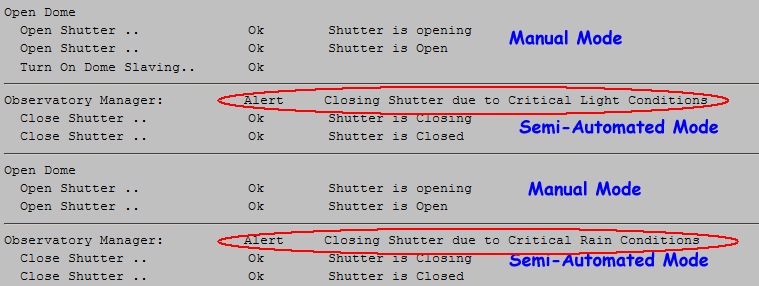 |
Back to Top
| This Web Page: | Notes - Session 611.2 (2018-05-22) |
| Last Updated : | 2023-11-29 |
| Site Owner : | David Richards |
| Home Page : | David's Astronomy Web Site |